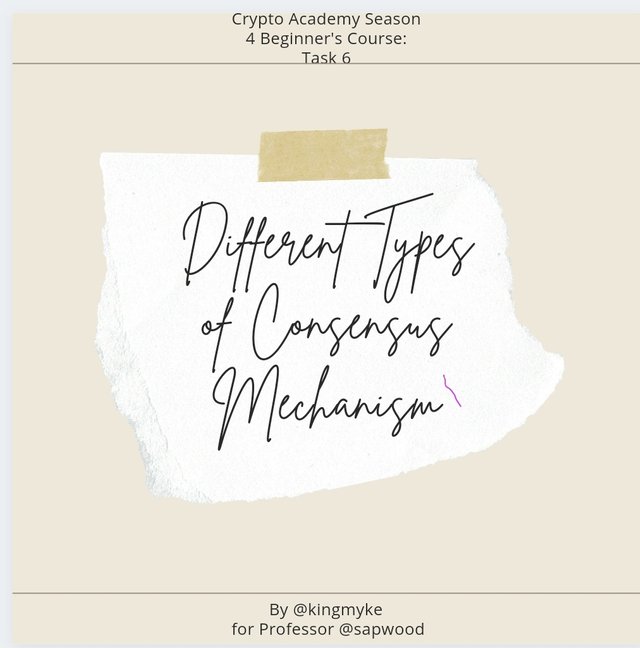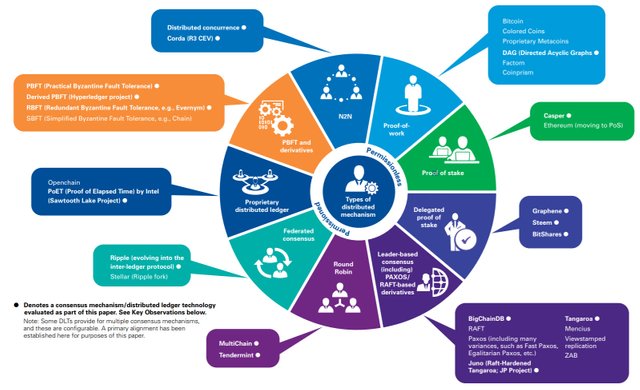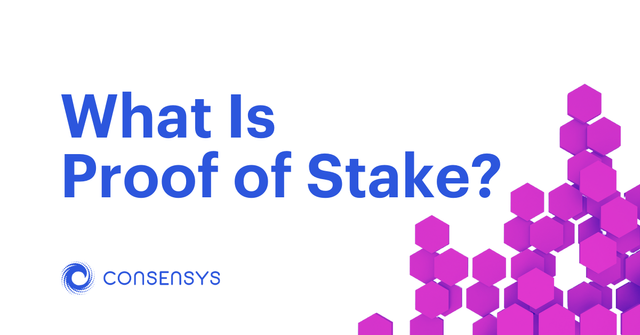Steemit Crypto Academy Season 4 Beginners' course - Homework Post for Task 6: Different Types of Consensus Mechanisms by @kingmyke
INTRODUCTION
Good day everyone. Thank you Professor @sapwood for your lecture. Having gone through the lecture by the Professor for the Steemit Crypto Academy Season 4 Beginners'Fixed course here, I am answering the questions that follow.
TASK 6
QUESTION 1
. What is the difference between PoW & PoS?
. Advantages & Disadvantages?
. Which one is better in scaling Capacity? Examples?
The Meaning Of Blockchain
It would be best to start this assignment with the meaning of blockchain.
A blockchain is simply a way of organizing data (a ledger, informat or data structure) that contains a series of transactions made in the cryptocurrency ecoyststem and the way in which these transactions are recorded makes it difficult to hack or break through the system.
The wonderful thing about a blockchain technology is that it is decentralized. In a conventional ledger system, all transaction entries and decisions are decided by a single or concentrated authority. In blockchain technology, This is not done that way. Rather, every single partcipant is involved in some way in the decision-making process of the blockchain.
This is in form of a consensus mechanism and that is what we will be discussing today. This system is so important and is the central idea behind the uniqueness of a blockchain technology.
Definition and Types Of Consensus Mechanisms
Simply put, a consensus mechanism is a series or collection of rules, protocols or regulations that is used by all the participants of a blockchain network or technology to come to n agreement if a ledger transaction in the blockchain is valid or not.
The aim of a consensus mechanism is to ensure that the ledger of every participant within the blockchain is the same and that a common agreement that is beneficial for the entire network technology is decided upon.
Types/Forms Of Consensus Mechanism
The first consensus mechanism used was Proof-Of-Work and this was implement when Satoshi Nakamoto created Bitcoin, The first cryptocurrency. Today, a variety of consensus mechanism have been developed is is being used by a variety of cryptocurrency ecosystem. Some of them include:
proof-of-stake (PoS)
Proof of Authority (PoA)
delegated proof-of-stake (DPoS),
proof-of-capacity (PoC),
Proof of Elapsed Time (PoET),
Byzantine Fault Tolerance (BFT)/Practical Byzantine fault tolerance (PBFT),
Proof of Burn (PoB),
and much more.
WHAT IS THE DIFFERENCE BETWEEEN PoW & PoS?
To be able to properly answer this question, I believe it is best for me to define what PoW and PoS are.
PoW ( PROOF OF WORK)
Proof of Work is a decentralized mechanism used by a cryptocurrency network to ensure that transactions are recorded in the system. In PoW, those responsible for ensuring this process, called miners, are given mathematical puzzles as a means to verify a transaction made on the blockchain. The miners compete to solve the puzzle and several miners using thousands of computers (which translates to the use of electricity) try to solve the puzzle. When a miner solves this puzzle, he shows that computing power has been used in order to solve the puzzle (hence the name "proof of work"), the transaction is validated and the miner is compensated and rewarded. After the transaction has been validated, it is keyed into/ recorded as a "block" in a chain of transactions, hence the name "blockchain". All the other miners who couldn't solve it first have just wasted time and electricity.
This is similar to when an accountant makes in finalized financial entry into a ledger, the only difference being that the "accountant" is any of the competing miners who is able to solve the mathematical puzzle and that this choice is completely random.
Litecoin and Bitcoin are some examples of cryptocurrencies that make use of the PoW mechanism.
PoS (Proof Of Stake)
This is a very interesting methodology and approach to mining and is relatively easy to understand. In PoS, a miner of a block is determined based on the amount or proportion of a coin being held. This means that larger holders of the particular coin in question are more likely to be block miners in the blockchain, ie, the higher the stake of the coin held by a holder, the more the power to mine (ie, the higher the mining power).
In PoS, the miner put up the tokens they have as collateral as they seek to be chosen to mine the next block.
Ethereum, whose token is Ether, plans to divert to the Proof Of Stake consensus mechanism as this announcement has been made for a while.
DIFFERENCES BETWEEN PoW AND PoS
| PoW | PoS |
|---|---|
| The right to mine is determined by the ability to solve the given puzzles first and fastest (ie, by computing power) | The right to mine is determined by the amount of a token/ coin in a holder's possession (ie the amount of tokens a holder owns) |
| It requires energy consumption ( it is energy inefficient) | It does not consume energy ( it is energy efficient) |
| Miners are given rewards as payment | Miners do not receive rewards (they are paid in network fees) |
| It is very decentralized | It tends to be quite centralized |
Advantages & Disadvantages?
PROOF OF WORK
Advantages
Reaching a consensus is done quickly.
It is very secure because it is highly decentralized.
Because Bitcoin uses Proof of Work and Bitcoin is the cryptocurrency with the highest valuation, PoW is the most battle tested.
|
Disadvantages
To carry out mining process of block creation via solving the given mathematical puzzles, a high amount of computation power is required. This process requires a large amount of energy as electricity.
The transaction process time is long ie, it is slow. This is because it will take time to solve the mathematical puzzles given that are tried by thousands of miners worldwide.
It is a highly expensive consensus mechanism. Sine the way of its functionality is based on the first miner to solve the cryptographic/ mathematical puzzles given, miners with the most sophisticated computer devices have a higher probability of winning and such devices are highly expensive.
Since only miners with the most powerful computer machinery have a high chance of winning, the job will always be in the hands of a privileged few. This problem tends to defeat the aim of the network, decentralization.
PROOF OF STAKE
Advantages
It requires low energy consumption because there is no need to purchase high utility hardware like in PoW which consumes high amount of electricity.
The speed of transaction process is high.
It provides a mechanism for punishing bad behavior, eg, in a case where a miner creates a faulty block. If a miner creates a fraudulent block, the tokens he put up as collateral will be taken from him.
It is decentralized. This is because the miners for different blocks are chosen in a random manner.
Price stability: In this mechanism, coins or tokens are not given to miners who successfully create blocks as reward compensation. This helps to keep the price of the coins less subject to volatility.
Disadvantages
It tends to limit liquidity
It tends towards centralization because mining a block depends on the amount of the token owned. So if wealthy individual hold large amount of tokens, they are chosen as miners, hence making it centralized.
It makes it difficult for center people (smaller investor) to participate as only very wealthy individual and institutions can hold large amount of the tokens and hence be chosen as miners.
Which one is better in scaling Capacity? Examples?
Scaling capacity is the ability to still function properly, effectively and efficiently even after there have been addition of features and utilities and well as an increase in its size and volume of something.
it is the ability of a blockchain to increase the number of transactions it can process per second. This is the meaning of scalability.
In the context of Proof Of Stake and Proof Of Work, the mechanism with better scaling capacity is Proof Of Stake. This is for the following reasons.
Lower electricity cost:
Since the PoS has been shown to have lower electricity consumption, it will be more scalable and even more open to mass adoption. More features can be added to the technologies behind a token running on a PoS mechanism as the developers need not worry about power consumption.
High transaction speed:
A major feature via which cryptocurrencies compete is based on transaction speed and cost. Cryptocurrencies with lower transaction cost and high transaction speed will be frontline tokens of the future.
This brings me to the discussion of ETH 2.0 also called Serenity.
Upgrades in the Ethereum ecosystem with the upcoming transition of Ethereum from PoW to PoS will being Ethereum's transaction speed from 15-45 transactions per second to thousands of transactions per second. This is the promise of PoS.
Examples of coins using PoW:
Monero
Monero was a created by Nicolas van Saberhagen on 18 April 2014. The interesting thing about Monero is tat it as designed to make its transaction details opaque. This means that senders received and the amount transacted is hidden by hiding the address of those involved in the transaction. It takes roughly 2 minutes to validate a Monero transaction.
Bitcoin
Nicknamed the "King Of Cryptocurrency" for the obvious reason that it was the first one ever created and the leading coin in terms of price per unit and market capitalization, Bitcoin was created on 3rd January 2009 by the yet unidentified Satoshi Nakamoto. Currently sitting at a price of $47,727 per unit, circulation supply of 18,817,837 and market cap of $898,063,920,779 as of the time of this writing, Bitcoin was written in PoW.
It has a scalability/ maximum transaction speed capacity of of 3.3 to 7 transactions per second and takes 10 minutes to mine a block.
Litecoin
Litecoin is a coin very similar to Bitcoin with just a few adjustments such as performing the same functionality as bitcoin but using a more lightweight approach as compared to bitcoin. It was created by by Charlie Lee in October 2011 as a spin off from Bitcoin and was one of the first altcoins as was often termed the Silver Of Bitcoin.
It has a scalability of 2.5 minutes per block created. Litecoin can handle 56 transactions per second on its blockchain.
Examples of coins using PoS:
Cardano
Cardano was founded in 2015 by the co-founder of Ethereum, Charles Hoskinson. who is still the largest holder of Cardano.
Cardano ensures complex transactions in a wonderful and scalable manner. The team that developed Cardano is a scientific team of experts such as programmers, researchers and engineers, IOHK, making Cardano the first cryptocurrency developed out of a scientific/research- driven approach.
The Cardano blockchain can handle 250 transactions per second.
Avalanche
Currently the fastest smart contract platform in the blockchain industry as measured by time taken to complete add finalize a transaction process (time-to-finality) ,with a transaction speed of 4500 transactions per second, Avalanche(AVAX) is currently the 12th coin ranked based on market capitalization. It was launched by Ava Labs on September 21, 2020 and has grown massively since then.
CONCLUSION
In 2009, Satoshi Nakamoto wrote the first lines of codes and created Bitcoin, the first ever cryptocurrency. Within those lines of code laid by Nakamoto were codes that were of the Proof Of Work mechanism. Many other early coins and some newer token have adopted this mechanism.
Due to its high energy demands as well as slow transaction processing capabilities, in 2012, Sunny King and Scott Nadal created the Proof Of Stake mechanism, one that is more scalable and has received a good amount of adoption by tokens.
With the ever innovative human mind trying to fight against energy wastage and speed up transaction time, much is to be seen in the cryptocurrency ecosystem as different consensus mechanism are created to achieve better functionality and utilization by people worldwide.
Thank you.
Special thanks to:
Professor @sapwood for the wonderful assignment
@awesononso
@reminiscence01
@whitestallion
@cryptokannon
@campusconnect
@ngoenyi
@dobartim
@whitestallion
@alphafx













